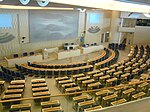User:Glitter/Sandbox2: Difference between revisions
No edit summary |
No edit summary |
||
| Line 1: | Line 1: | ||
{{Infobox legislature | {{Infobox legislature | ||
|name = | |name = Comhthionól Náisiúnta | ||
|legislature = | |legislature = | ||
|coa_pic = Seanad Logo.png | |coa_pic = Seanad Logo.png | ||
|coa_res = 150px | |coa_res = 150px | ||
|session_room = | |session_room = Plenisalen.jpg | ||
|house_type = | | session_res = 150px | ||
|body = | |house_type = {{wp|Lower house}} | ||
|body = | |||
|leader1_type = | |leader1_type = | ||
|leader1 = | |leader1 = | ||
|party1 = | |party1 = | ||
|members = | |members = | ||
|structure1 = | |structure1 = | ||
|structure1_res = | |structure1_res = | ||
|term_length = | |term_length = | ||
|established = | |established = 1857 | ||
|disbanded = 2021 | |disbanded = 2021 | ||
|voting_system1 = | |voting_system1 = | ||
|redistricting = | |redistricting = | ||
|meeting_place = | |meeting_place = Comhthionól Chamber<br />[[Carrowdun Palace]], [[Spálgleann]] | ||
|website = | |website = | ||
}} | }} | ||
''' | The '''Comhthionól Náisiúnta''' (literally "National Assembly") was the {{wp|lower house}} of the {{wp|Bicameralism|bicameral}} [[Tionól (Bicameral)|Tionól]] of [[Caldia]] from 1857 until 2021. It was also the principal chamber. During the bicameral period, the {{wp|upper house}} was the [[Seanad Glaíteann]] (literally "{{wp|Senate}} of Caldia"). | ||
It | The chamber's powers were similar to those of lower houses under many other bicameral parliamentary systems. It became the dominant chamber of the Tionól starting in 1965. It had the power to pass any law it wishes. It was also responsible for nominating nominate and removing the [[Taoiseach of Caldia|taoiseach]], who had to belong to the chamber. | ||
It had 399 members who were directly elected every five years. 200 of its members were elected from multi-member constituencies and the remaining 199 members were elected using a party list proportional method. | |||
The chamber effectively became the {{wp|unicameralism|unicameral}} [[Tionól]] starting on 12 May 2021. | |||
==Historical origins== | |||
==Composition== | ==Composition== | ||
==Leadership== | ==Leadership== | ||
Revision as of 18:03, 15 June 2021
Comhthionól Náisiúnta | |
|---|---|
 | |
| Type | |
| Type | |
| History | |
| Established | 1857 |
| Disbanded | 2021 |
| Meeting place | |
 | |
| Comhthionól Chamber Carrowdun Palace, Spálgleann | |
The Comhthionól Náisiúnta (literally "National Assembly") was the lower house of the bicameral Tionól of Caldia from 1857 until 2021. It was also the principal chamber. During the bicameral period, the upper house was the Seanad Glaíteann (literally "Senate of Caldia").
The chamber's powers were similar to those of lower houses under many other bicameral parliamentary systems. It became the dominant chamber of the Tionól starting in 1965. It had the power to pass any law it wishes. It was also responsible for nominating nominate and removing the taoiseach, who had to belong to the chamber.
It had 399 members who were directly elected every five years. 200 of its members were elected from multi-member constituencies and the remaining 199 members were elected using a party list proportional method.
The chamber effectively became the unicameral Tionól starting on 12 May 2021.